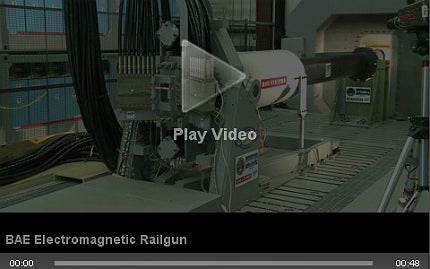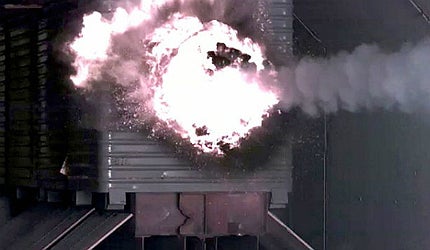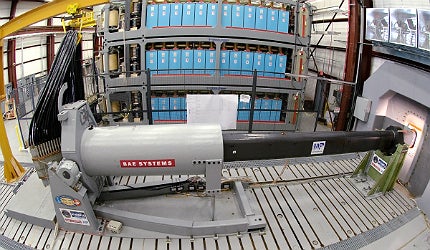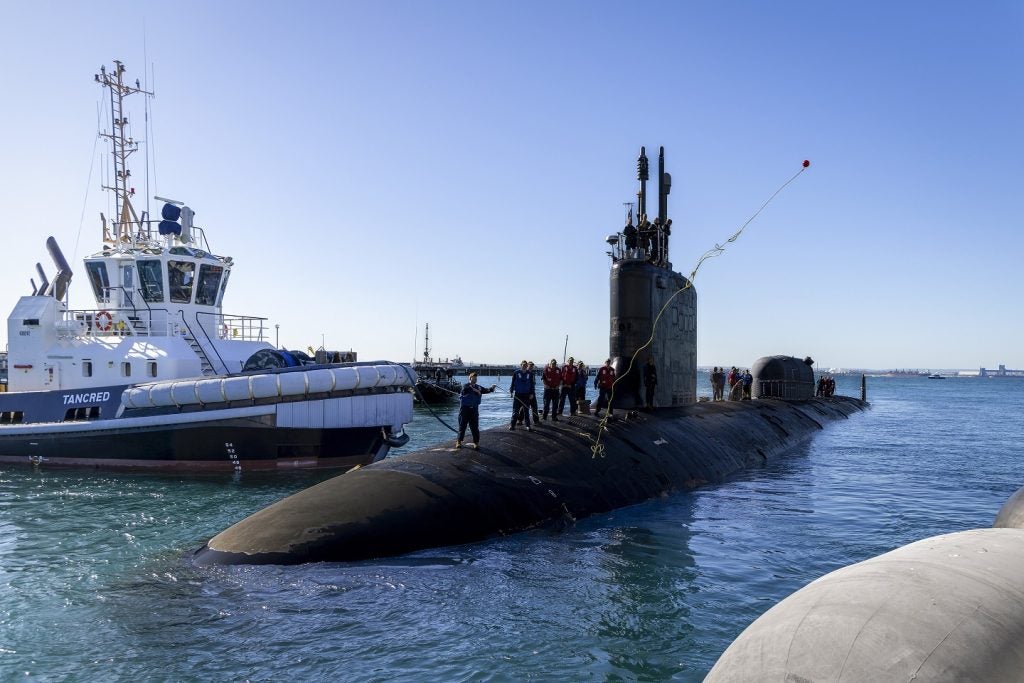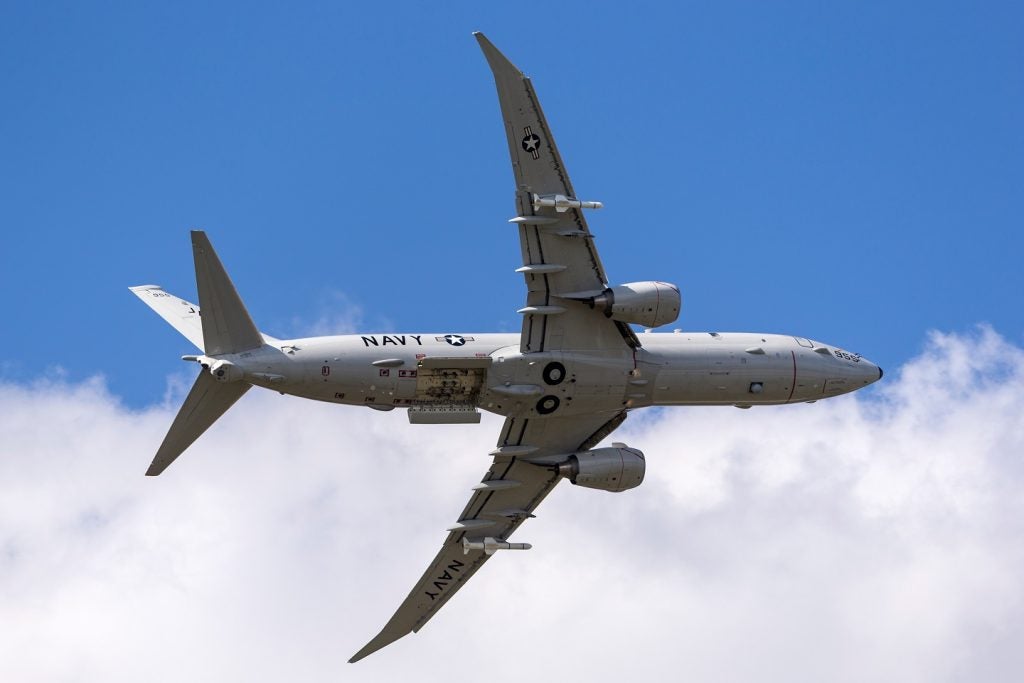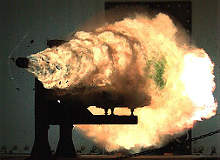
Principles of railgun design
Railguns consist of two parallel metal rails, between which a projectile held in an armature is loaded, completing a circuit between them. A massive electrical current of the order of one million amperes is applied, creating an electromagnetic field, which in turn produces a force that accelerates the projectile along the rails.
A railgun offers a number of potential advantages over traditional explosive projectile weapons. The accelerating force is applied to the projectile for the entire time the projectile is between the rails of the launch device, as opposed to explosive forces which, however powerful, have a limited duration.
This means much higher velocities can be reached – potentially Mach 10 at sea level, or more than three times the muzzle speed of an M16 rifle – than can be achieved through explosive forces. In turn, this could result in it having a range 220 miles, which is around ten times further than any other gun.
How well do you really know your competitors?
Access the most comprehensive Company Profiles on the market, powered by GlobalData. Save hours of research. Gain competitive edge.

Thank you!
Your download email will arrive shortly
Not ready to buy yet? Download a free sample
We are confident about the unique quality of our Company Profiles. However, we want you to make the most beneficial decision for your business, so we offer a free sample that you can download by submitting the below form
By GlobalDataRailgun projectiles are generally non-explosive, relying on their enormous speed to destroy the target and thus reducing the risk of a fire on board a ship, and comparatively small and lightweight, so they can be more readily transported and stored. The kinetic energy they deliver could do as much damage as a Tomahawk missile, enabling them to travel clean through a ship.
High speeds mean projectiles are much less affected than conventional weapons by factors such as wind, allowing them to retain pinpoint accuracy across a large distance, rather than needing on-board trajectory correction, making them considerably cheaper.
History of the railgun
The force with which the projectiles left the muzzle was 33 megajoules
The principle of using an electromagnetic force to propel projectiles at high velocity has been around since World War I, when French inventor Louis Octave Fauchon-Villeplee invented an electric cannon in 1918, based on the principles of the linear motor. German scientists also designed, but never developed, an electric anti-aircraft gun during World War II.
To give an idea of the potential power of modern systems, in December 2010 General Atomics set a new world record during a test-firing of its Blitzer electromagnetic railgun. The company gained experience of powerful electromagnetic technology through work it carried out to support the nuclear industry, having worked on electromagnets for the International Thermonuclear Experimental Reactor (ITER).
The projectiles, which were subjected to acceleration levels exceeding 60,000g, reached speeds of Mach 5. The force with which the projectiles left the muzzle was 33 megajoules — a single megajoule is roughly equivalent to a one-ton car travelling at 100mph.
Budget hitches
In June 2011, the US Navy came within an inch of having to drop the railgun programme altogether following the authorisation of the fiscal 2012 defence authorisation bill by the Senate Armed Services Committee. However, the other three committees overseeing military budgets decided the project was worth continuing. There is still a risk the railgun may suffer further reductions in funding as other budget cuts are announced, but for now it is safe.
US Navy programme latest
For the next phase the ONR recently awarded $10m contracts to Raytheon, BAE Systems and General Atomics
In early February 2012, BAE Systems delivered the first of two prototype advanced railguns to the US Naval Surface Warfare Center Dahlgren Division (NSWCDD) for testing, two years after being awarded the contract by the Office of Naval Research (ONR). The first of two, month-long test series began later in the month, with each firing testing its extended range capabilities against surface, air and ground targets at various energy levels.
The second General Atomics-built prototype launcher was delivered in April 2012 with trials progressing to firing an aerodynamic round developed by Boeing. It achieved speeds of Mach 5, and with zero gun elevation it penetrated a steel plate an eighth of an inch thick 100 yards away, then travelled seven kilometres down range before it stopped.
Tom Hun of General Atomics indicted that in discussions with the navy, General Atomics had identified the USS Arleigh-Burke (DDG-51) as a likely candidate test platform for sea trials.
For the next phase the ONR recently awarded $10m contracts to Raytheon, BAE Systems and General Atomics to develop a pulsed power system for launching projectiles in rapid succession. Targeting a firing rate of six to ten 50mm rounds a minute, the naval power system is expected to be operational by 2025.
Challenges of railgun development
In addition to the prohibitive costs of build and operation, several technical problems still need to be overcome to make the railgun a viable weapon.
A source of powerful electrical current is required, which limits its use to fixed locations, and the massive bank of capacitors required to generate the charge would easily take up any room on board a ship saved by smaller ammunition. Furthermore, the current itself damages the rails every time the system is used, due to the enormous force between the rails and the arcing, which vaporises the surface. The magnetic fields generated during launch can cause damage to electronic equipment, so the ship must be shielded, and the power could even blow the device apart.
In addition, the friction between the projectile and the rails generates heat, which can make the railgun easy to detect and further damage the rails, leading to inaccuracy. If similar guidance systems to modern missiles are to be added to overcome this, they would need to be highly temperature-resistant so as not to melt during the hypersonic electronic launch.
The target rate of six to ten rounds a minute could be ambitious as some technicians believe it could take at least a minute to charge up between shots.
Related content
Future Navy – technology to look out for in 2012
As naval warfare continues to evolve new technology is beginning to make waves.
Tomahawk Long-Range Cruise Missile, United States of America
The Tomahawk is a long-range, all-weather, subsonic cruise missile in service with the surface ships and submarines of the US and Royal Navy.
Arleigh Burke Class (Aegis) Destroyer, US
The first Arleigh Burke Class Aegis destroyer was commissioned in 1991.

